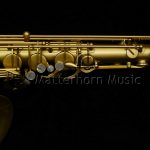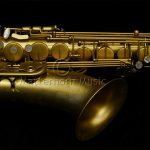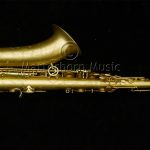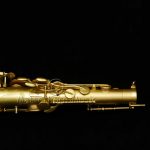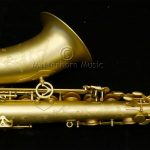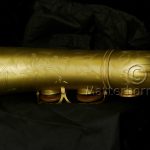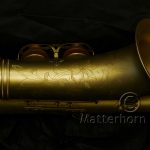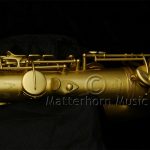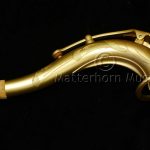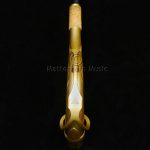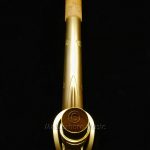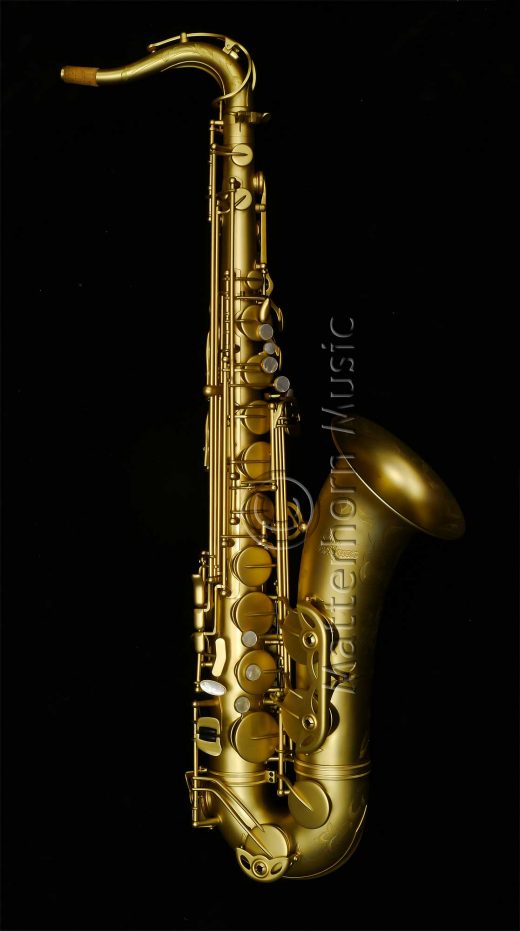 Antigua Model 25 Tenor – TS4348
Antigua Model 25 Tenor – TS4348
Price: Varies, but in Dec. 2019 the prices I’ve seen range from $3091 (after conversion from €) to $3426 US.
At the time writing, Matterhorn Music hasn’t priced theirs yet.
Date of manufacturing: circa 2018
Date of review: 2019
Setup used: Dukoff S7 with Légère 2 ¼ reed & Rovner light lig.
When David asked me to try the Antigua Winds Model 25 alto he ordered in I was really impressed. So impressed in fact, that he ordered a tenor. Truth be told, the tenor is not nearly as impressive as the alto is.
There is just something about the alto that reminds me of my King Zephyr. The alto vibrates in your hands, and has a breadth, depth, and complexity to its sound that I’m not used to hearing from modern horns these days. (More about that in the alto review which will follow in the coming weeks.)
Having said that, the Antigua Model 25 tenor sax is a really nice horn. It is solid, and certainly challenges the stereotypes I have of modern horns in general, and Asian-made ones specifically.
Tone
The Antigua Model 25 is an interesting mix of core tone and overtones. The tone was dark—meaning it was very heavy on core tone—yet it had lots of overtones present as well when it combined with my Dukoff S7. Given the limitations of my iPhone’s recording program, this tonal complexity was not adequately captured in any of the recordings I did.
Compared to lots of modern horns I’ve played, the Model 25 definitely has a vintage vibe to it.
FWIW, here is a small sound sample of this Antigua TS4348 when paired with my vintage Dukoff S7 and a Légère 2 ¼ reed, as well as a Rovner Light lig.
To get a better idea of what the sax sounds like when recorded with proper sound gear 😉 , here is Antigua’s sound sample of the Model 25…
Response
The Antigua Model 25 is a very free blowing horn. It offers very little resistance, compared to say most Selmer Paris horns. It is not quite as free blowing as my King Zephyr, but it is close.
The TS4348 plays even up and down the entire range of the horn.
Feel
The TS4348 is extremely well set up. Despite it having blue needle springs, the key action didn’t feel stiff. (That is one of my biggest personal complaints about them.)
The horn itself was very comfortable to play. The keys are located in such a way that I had no difficulty in finding my way around the horn quite quickly.
Unlike the Antigua alto that played right out of the box, the Model 25 tenor needed some adjustments and has suffered from some metal memory issues. However, now that the G key has been adjusted a couple of times it is holding and the horn plays really well.
Intonation
Given that I’ve only spent about 15 or so minutes playing it, the Antigua 25 tenor plays remarkably in tune for me.
F# 1 & 2 |
Perfectly in tune |
F# 1 – Bb 1 |
All in tune with only minor embouchure adjustments |
F#1 – F# 3 |
All in tune with only minor embouchure adjustments |
Specs
According to the Antigua website, this horn has some very interesting qualities and features 1 :
SERIES |
Model 25 |
KEY |
Bb |
NECK |
Newly designed |
BODY |
Yellow brass |
TONE HOLES |
Rolled Tone Holes |
KEY ARMS |
Double key arms on low C, B and Bb |
PADS & RESONATORS |
PISONI pads & metal resonators |
BELL DECORATION |
New hand engraving pattern unique to the Model 25 |
THUMB HOOK |
Newly designed |
FINISH |
Brass with unlacquered finish |
FEATURES:
- Completely unlacquered finish.
- Includes the popular enlarged bell featured on our power bell horns.
- Double braced pad cups on the low C, B & Bb keys.
- Redesigned thumb hook for maximum comfort.
- Redesigned post arrangement on the low C and Eb keys are now two posts with a single rod.
- Adjustable screw at Low B.
- New hand engraving pattern unique to the Model 25.
- Cryogenic treated saxophone.
RINGED TONE HOLES:
- Advantage – the drawn tone hole has a hand soldered ring.
- This gives the player the benefits of a rolled tone hole but will be more solid construction.
- Provides a more consistent pad seating surface than the standard rolled tone hole.
- Standard rolled tone holes require an additional 5mm in order to create the roll. This tends to give added stress to the tone hole.
CRYOGENIC TREATMENT:
Since the 20th Century, cryogenic treatment has been largely applied to different types of metal products. Research has proven that cryogenic treatment can enhance the mechanical and physical properties of many materials.
The cryogenic treatment process is to bring the material to a very low temperature, by using liquid nitrogen. The best temperature to apply to a saxophone when being cryogenically treated is -196 degrees. This treatment can improve the strength of the brass, reduce residual stresses and improve wear resistance. In addition, cryogenic treatment is also sought for its ability to improve corrosion resistance.
After numerous testing, we found out that the cryogenic treated saxophone has a rounder tone, better resonance, less resistance when playing and fuller sound throughout the entire register. These benefits are why we decided to apply this treatment to our professional saxophones. We believe that this will give you an even better playing experience when comparing the playability to non-cryogenically treated saxophones.
1 This entire section was quoted directly from the Antigua website. 😉
_____________________________________________________________________________________
Pics of the Antigua Model 25 TS4348
I shot these in the shop on a cloudy day. The big bank of windows works really well (for the most part) to provide decent lighting. Enjoy the sax porn… It is a good-looking horn.
Build
Note: I feel like I need to add an updated version of my usual disclaimer here…
Although I now work a couple of days a week for my tech as his Education Representative, I am not a tech, nor do I play one on TV. 😆 I am however, a sax player with three decades of playing experience who has spent a great many hours with my techs, talking with them, learning from them, and applying that knowledge to the saxophones that I purchase for myself, as well as my students.
Cons
I wanted to fall in love with this horn and have absolutely no reservations. I would love to have a horn that I could recommend without hesitation to my students who have outgrown their student horns. There were however, a couple of things that gave me pause.
Neither of the following are deal-breakers. However, if I were to rate this horn with stars, these would cause me to give it a 4 rather than a 5 star rating. 😉
Play in the keys
The most worrying thing is that for a sax with less than 2 hours of total playing time on it, I can’t understand why there should be play in any of they keys. Yet there is. There is up and down movement in the high F# key—a key that would have hardly been used either by myself or the other sax player in the shop who play-tested the horn.
There is also some up and down movement in the octave key. Again, I wonder why. Two hours of use should not have loosened the mechanism enough to cause loose play in any key.
Yes, those keys will be fixed, but the question I have is will others soon follow? I have played my vintage horns for decades, and it is only after many, many, many years of constant use that I encounter play in keys. Why do new horns—and this is certainly not the first new sax I have encountered this in—develop this problem in mere hours, while vintage horns don’t? I’ll let you talk amongst yourselves and try to figure that one out. 🙂
Finish
I love the finish. There is something about a completely unlacquered finish that makes a horn look simply cool. 😎 I know from personal experience though, that unlacquered horns show EVERYTHING. This Model 25 by Antigua is no exception.
For the play testing we used a K&M stand. These stands are specially designed not to mark your horn. Guess what: it left scuff marks.
Unlacquered horns are very prone to water marks. Yup, despite our best efforts not to let a drop of water hit the horn, one or two did. Even drying them right away leaves a mark.
The takeaway from this is that as beautiful as this unlacquered finish is, if you want to keep it looking good, it will be high maintenance. Just check those Dave Guardala, et al. Earthtone horns that B&S put out and see what they look like now when they pop up for sale. That will likely give you a good idea of what the Model 25 will look like in a few years if you let the finish slide.
Can’t find a B&S sax to compare? You can always look at my 1950 Zephyr that has lost pretty much 99% of its lacquer due to use. It is a killer axe that caused my Mark VI to become my back-up horn. But guess what: The Zephyr’s bare brass finish is not pretty and gives us a pretty good idea of what an unlacquered horn will look like if it is a working horn. But then I didnt’ buy it for its looks, I bought it for its sound. 😉
Pros
Those two cons aside, this Antigua Model 25 TS4348 has a lot more going for it than against it.
Rolled tone holes
I really like the rolled—or ringed as Antigua calls them—tone holes. Like Keilwerth has been doing on the SX 90R series for years now, the tone holes on these Model 25 are not true rolled tone holes per say. (See description above.) However, the end effect of the soldered ring is the same as a true rolled tone hole.
Personally, I like rolled tone holes on my saxes. I have quite a number of saxes that have them (JK, D&J, Kohlert, et al.) and while I can’t personally hear a difference in tone in horns with rolled tone holes vs. those that don’t, what I do like is the feeling under my fingers when the keys seal on rolled holes.
To be fair, some people don’t like rolled tone holes because they are more prone to sticking, but that’s nothing that proper maintenance won’t keep in check.
Finish
I simply loved the hand engraving that is not only on the bell and bow, but on the body tube and neck as well. It shows up really well on the bare-brass finish, and makes this horn look simply stunning.
Ribbed construction
When you pick up the Model 25 TS4348, you are immediately struck by its weight. Upon looking at it you can see it has ribs, and that the majority of posts are not attached directly to the body tube. I really like this feature since it is something that many of my personal saxes have.
These ribs will contribute somewhat towards the Model 25’s weight, and likely towards its overall tone.
Bottom line
The Antigua Model 25 TS4348 is a good, solid horn. Given all the Asian junk that’s out there, this one stands out from a great number of them.
The Model 25 would be ideal for any of the following players:
- Doublers who need a solid sax for their pit or other gigs, but don’t have the $$ to get a new horn from the big four. (Selmer, Keilwerth, Yamaha, or Yanagisawa)
- High school students who have outgrown their student model horns, and are looking to upgrade, and again don’t have the $$ for a new horn from the big four.
- Adults returning to playing after taking years off after school. These horns are great for returning and amateur players.
- Weekend warriors looking for that vintage vibe without going down the vintage sax road of ergonomics, intonation quirks, etc. etc.
- Anyone wanting to buy a new saxophone that has a more unique sound than what’s being served up by many of the Asian-made, mass-produced clone horns currently on the market.




